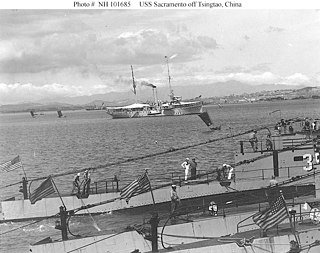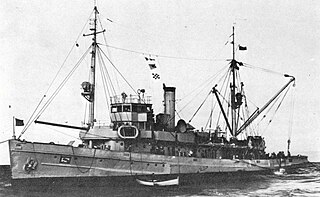
USS Wyoming was the second ship of the United States Navy to bear that name, but the first to bear it in honor of the 44th state. The first Wyoming was named for Wyoming Valley in eastern Pennsylvania.

The second USS Buffalo was an auxiliary cruiser of the United States Navy, and later a destroyer tender.

The seventh USS Washington (ACR-11/CA-11/IX-39), also referred to as "Armored Cruiser No. 11", and later renamed Seattle and reclassified CA-11 and IX-39, was a United States Navy Tennessee-class armored cruiser. She was laid down on 23 September 1903 at Camden, New Jersey, by the New York Shipbuilding Corporation, launched on 18 March 1905, sponsored by Miss Helen Stewart Wilson, daughter of United States Senator John L. Wilson of Washington state, and commissioned at the Philadelphia Navy Yard on 7 August 1906, Captain James D. Adams in command.

USS Dolphin (PG-24) was a gunboat/dispatch vessel; the fourth ship of the United States Navy to share the name. Dolphin's keel was laid down by Delaware River Iron Ship Building and Engine Works of Chester, Pennsylvania. She was launched on 12 April 1884, with Captain George Dewey in command, and commissioned on 8 December 1885 with Captain R. W. Meade in command. Dolphin was the first Navy ship to fly the flag of the president of the United States during President Chester A. Arthur's administration, and the second Navy ship to serve as a presidential yacht.

USS Raleigh (C-8) was a United States Navy protected cruiser of the Cincinnati class, commissioned in 1894 and in periodic service until 1919.

The second USS Sacramento (PG-19) was a gunboat in the United States Navy.

USS Hopkins (DD-6) was a Hopkins-class destroyer, which was a sub-class of the Bainbridge-class destroyer, in the United States Navy. She was the first of three Navy vessels named in honor of Commodore of the Continental Navy Esek Hopkins.

USS Denver (C-14/PG-28/CL-16) was the lead ship of her class of protected cruisers in the United States Navy. She was the first Navy ship named for the city of Denver, the capital of Colorado.

The second USS Marblehead (C-11/PG-27) was a Montgomery-class unprotected cruiser in the United States Navy, authorized in the naval appropriations bill of September 7, 1888. Marblehead served in the Spanish–American War and World War I, and was the last ship of her class in service.

USS Yorktown was lead ship of her class of steel-hulled, twin-screw gunboats in the United States Navy in the late 19th and early 20th centuries. She was the second U.S. Navy ship named in honor of the American Revolutionary War's Battle of Yorktown.

USS Fox (DD-234/AG-85) was a Clemson-class destroyer in the United States Navy during World War II. She was the fourth ship named for Gustavus Vasa Fox, Assistant Secretary of the Navy during the Civil War.

The second USS Milwaukee (C-21) was a St. Louis-class protected cruiser in the United States Navy. Entering service in 1906, Milwaukee was deployed to the Pacific Ocean. On 13 January 1917, while aiding a grounded submarine, the cruiser grounded herself. The ship was decommissioned and sold for scrap in 1919.

The first USS Saturn (AG-4) was an iron collier in the United States Navy.

USNS Salvor (T-ARS-52) is a Safeguard-class rescue and salvage ship, the second United States Navy ship of that name.

The first USS Machias (PG-5), a schooner-rigged gunboat, was laid down in February 1891 by Bath Iron Works, Bath, Maine. She was launched on 8 December 1891. She was sponsored by Miss Ethel Hyde, daughter of President Hyde of Bath Iron Works and commissioned at Portsmouth Navy Yard, Kittery, Maine, 20 July 1893, Commander Charles J. Train in command.

USS Robin (AM-3) was an Lapwing-class minesweeper acquired by the U.S. Navy for the dangerous task of removing mines from minefields laid in the water to prevent ships from passing.

The first USS Ortolan(AM-45/ASR-5) was a Lapwing-class minesweeper in the United States Navy. She was later converted to a submarine rescue ship. She was named after the ortolan, a European bunting.

USS Oceanographer (AGS-3) was a survey ship of the United States Navy during World War II that produced charts chiefly of passages in the Solomon Islands area of the Pacific Ocean. Upon transfer to the Navy, she had initially briefly been named and classed as gunboat USS Natchez (PG-85). Before her World War II Navy service, she had been USC&GS Oceanographer (OSS-26), a survey ship with the U.S. Coast and Geodetic Survey from 1930.

USNS Marine Adder (T-AP–193) was a troop ship for the United States Navy in the 1950s. She was built in 1945 for the United States Maritime Commission as SS Marine Adder, a Type C4-S-A3 troop ship, by the Kaiser Company during World War II. In 1950, the ship was transferred to the Military Sea Transport Service of the U.S. Navy as a United States Naval Ship staffed by a civilian crew. After ending her naval service in 1957, she entered the National Defense Reserve Fleet, but was sold for commercial use in 1967. She was used in part to carry supplies to support the Vietnam War efforts. During the summer of ‘72 while in Da Nang harbor, South Vietnam a limpet mine was attached to the hull by a swimmer. The mine blew a hole in the hull. In order to save the ship the Skipper ran it aground in Da Nang harbor. The USS Navy standby salvage ship USS Grasp with its crew of divers installed a box patch over the hole and pumped the water from the bilges, before moving the ship to a pier. US Army tanks hung from ship booms to heel the ship so that a metal patch could be welded in place to return the ship to duty. SS Transcolorado, she was chartered by the Military Sealift Command as a civilian cargo ship designated T-AK-2005.

Captain Allen Bevins Reed was a U.S. Naval officer whose career began aboard vessels in the Asiatic and Pacific Fleets. Early in his career he was Captain Takeshita Isamu's escort during a ceremonial visit to the mayor of San Francisco, and he was a member of a Naval Board of Inquiry. Reed assumed the command of a landing force of 120 men in Nicaragua in 1912, to protect a railway line following a coup d'état attempt by General Luis Mena.





















